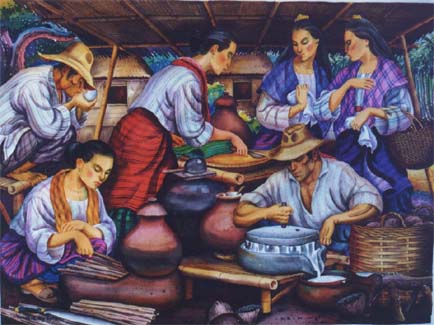GUSTO
![]()

BIBINGKA GALAPONG
ni M. Evangelista
Student Translation
(I-click ang link sa itaas at
may separate
window na lilitaw kung saan makikita
ang listahan ng lahat ng translation tools
na maaring
magamit para sa dokumentong ito.)
Gusto and ayaw are both used to express and describe what someone likes or not like doing in Tagalog. Both are used together with most -um- and mag- verbs and some ma- verbs in their infinitive forms. Some examples are:
_________. He likes to cook fish.
___________. I don't like to play outside.
_________.Tess likes to eat at the Kamayan Restaurant.
The following table shows how sentences are constructed using gusto and ayaw together with the verbs.
| Gusto/Ayaw | ba | ng construction (actor) | ba + ng |
Infinitive Form | Non-Actor Complement |
| Gusto/Ayaw | kong | lumangoy. | |||
| Gusto/Ayaw | ng batang | maligo. | |||
| Gusto/Ayaw | ba | ni Pedro nina Bert |
mag-aral. maglaro |
ng tenis. |
|
| Gusto/Ayaw | mo | bang | magpasyal | sa karnabal. |
Gusto can occur with another verb in the infinitive form. The linker na or ng always occur between this verb and the word that precedes and follows it.
Filipinos often invite friends to do something, by asking them a yes/no question.
_________. Do you like to go to Manila tomorrow?
_________. Do you like to eat out with Ben later on?
_________. Don't you like to eat with us at our house?
_________. Don't you like to visit Chicago on Saturday?
_________. Do you like to cook "pancit"? Come/Go to our house on Sunday.
Some friends may be asked these questions, and they have to have a good alibi if they cannot accept the invitation. Some examples of good alibis are as follows:
I like to go to Manila but I am very busy tomorrow.
I like to eat out later but I don't have money.
I like to sleep over at your house but my mother might get angry.
I don't like to cook fish in the house because it smells.